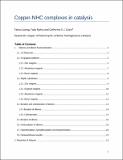Files in this item
Copper-NHC complexes in catalysis
Item metadata
| dc.contributor.author | Lazreg, Faima | |
| dc.contributor.author | Nahra, Fady | |
| dc.contributor.author | Cazin, Catherine S.J. | |
| dc.date.accessioned | 2016-02-04T00:13:18Z | |
| dc.date.available | 2016-02-04T00:13:18Z | |
| dc.date.issued | 2015-06-15 | |
| dc.identifier | 171442393 | |
| dc.identifier | f942c510-3c29-42bc-9488-ebe71ead18a2 | |
| dc.identifier | 84939288844 | |
| dc.identifier | 000355036800004 | |
| dc.identifier.citation | Lazreg , F , Nahra , F & Cazin , C S J 2015 , ' Copper-NHC complexes in catalysis ' , Coordination Chemistry Reviews , vol. 293-294 , pp. 48-79 . https://doi.org/10.1016/j.ccr.2014.12.019 | en |
| dc.identifier.issn | 0010-8545 | |
| dc.identifier.uri | https://hdl.handle.net/10023/8126 | |
| dc.description | The authors gratefully acknowledge the Royal Society (University Research Fellowship to C.S.J.C.) for funding. | en |
| dc.description.abstract | Although the chemistry of copper has a long history [1a-d], the relatively recent discovery of N-heterocyclic carbene (NHC) as transition-metal supporting ligands has permitted novel vistas to be explored in copper reactivity and catalysis [1e,f]. Shortly after the seminal discovery of Arduengo, Raubenheimer reported a neutral copper carbene complex [1] and [2]. However, the field remained dormant for almost ten years. In the early 2000s, new breakthroughs were achieved: first, the synthesis of NHC–copper using Cu2O was reported by Danopoulos and followed by the first application in catalysis by Woodward [3] and [4]. The work by Buchwald and Sadighi appeared next, where the first catalysis using a well-defined complex was described [5]. The first reports in this field were based on systems used to mimic their phosphine relatives. NHCs have become ligands of significant interest due to their steric and electronic properties [6], [7] and [8]. Combining the NHC ligand family and copper became, for some, an obvious and productive area [6]. Over the last decade alone, numerous systems have been developed. Copper–NHC complexes can be divided into two major classes: neutral mono-NHC and cationic bis-NHC derivatives: [Cu(X)(NHC)] [9] (X = halide, acetate, hydroxide, hydride, etc.) and [Cu(NHC)(L)][Y] (L = NHC or PR3; Y = PF6, BF4) [10]. The neutral-halide-bearing complexes have been widely used in catalysis, mainly due to their ease of synthesis [9]. In addition to halide-bearing complexes, notable important related compounds have been reported: Nolan and co-workers disclosed the first hydroxide derivative [Cu(OH)(IPr)] (IPr = N,N’-bis(2,6-di-isopropylphenyl)imidazol-2-ylidene) and Sadighi published alkoxides, hydrides and borate species, which permitted novel reactivity to be explored [9g-i]. With respect to cationic derivatives, homoleptic and heteroleptic bis-NHC complexes have been reported and have been efficiently used in catalysis allowing important improvements [10]. In this review, an overview of the two classes and their respective catalytic performance will be presented. | |
| dc.format.extent | 2372677 | |
| dc.language.iso | eng | |
| dc.relation.ispartof | Coordination Chemistry Reviews | en |
| dc.subject | Copper | en |
| dc.subject | N-heterocyclic carbene | en |
| dc.subject | Homogeneous catalysis | en |
| dc.subject | QD Chemistry | en |
| dc.subject | NDAS | en |
| dc.subject.lcc | QD | en |
| dc.title | Copper-NHC complexes in catalysis | en |
| dc.type | Journal article | en |
| dc.contributor.sponsor | The Royal Society | en |
| dc.contributor.institution | University of St Andrews. School of Chemistry | en |
| dc.contributor.institution | University of St Andrews. EaSTCHEM | en |
| dc.identifier.doi | 10.1016/j.ccr.2014.12.019 | |
| dc.description.status | Peer reviewed | en |
| dc.date.embargoedUntil | 2016-02-04 | |
| dc.identifier.grantnumber | UF100691 | en |
This item appears in the following Collection(s)
Items in the St Andrews Research Repository are protected by copyright, with all rights reserved, unless otherwise indicated.

